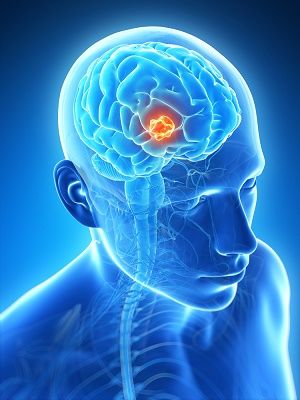TTFields Plus Temozolomide/Pembrolizumab Controls Tumors in Glioblastoma
Patients with newly diagnosed glioblastoma had improved survival when treated with TTFields plus temozolomide and pembrolizumab.
A longer survival was noted when patients underwent biopsy only vs maximal resection. The median PFS was 27.2 months vs 9.6 months (HR, 0.37; 95% CI, 0.16-0.85; P = .014). The median OS was 31.6 months vs 18.8 months (HR, 0.40; 95% CI, 0.17-0.92; P = .023).

Complete in situ vaccination and anti–PD-1 immunotherapy led to T-cell expansion and clonal replacement, which in turn led to tumor control for patients with glioblastoma, according to a presentation from the 2024 Society for Immunotherapy of Cancer Annual Meeting.1
Results were highlighted in the phase 2 2-THE-TOP trial (NCT03405792) analyzing the safety and efficacy of adjuvant temozolomide (Temodar) plus tumor treating fields (TTFields; Optune) and pembrolizumab (Keytruda) for patients with newly diagnosed glioblastoma.The data from the trial were compared with a matched-control cohort of patients who received TTFields plus temozolomide. Investigators found the median progression-free survival (PFS) in the experimental arm reached 12 months vs 5.8 in the control arm (HR, 0.377; 95% CI, 0.217-0.653; P = .00261). The median overall survival (OS) was 24.8 months vs 14.6 months (HR, 0.522; 95% CI, 0.301-0.905; P = .04768).
A longer survival was noted when patients underwent biopsy only vs maximal resection. The median PFS was 27.2 months vs 9.6 months (HR, 0.37; 95% CI, 0.16-0.85; P = .014). The median OS was 31.6 months vs 18.8 months (HR, 0.40; 95% CI, 0.17-0.92; P = .023). A high objective response was also noted for patients with biopsy-only tumors.
The most common grade 1/2 adverse effects included nausea (n = 29), rash (n = 22), vomiting (n = 14), and pruritus/itching (n = 14). Additionally, grade 3/4 effects were minimal, with the most common being fatigue (n = 6).
“The hypothesis was created that TTFields plus pembrolizumab creates a therapeutic synergy,” David D. Tran, MD, PhD, stated during the presentation. “Patients with bulky, unresectable tumors are associated with more robust in-situ vaccination, enhanced anti-tumor immunity, and longer survival compared with those with maximally reduced tumors.”
Tran is the chief of the Division of Neuro-Oncology and co-director of the Brain Tumor Center at the University of Southern California.
The 2-THE-TOP trial enrolled patients with newly diagnosed glioblastoma. At week 1, concurrent radiotherapy and temozolomide were given. At 2 weeks to 24 months, pembrolizumab was given for up to 34 cycles.
Patients who received biopsy only and were given pembrolizumab underwent clonal replacement, which investigators found correlated with survival. Pre-TTFields vs cycle 1, the Iogrank P value was 0.443. At cycle 1 vs cycle 4, the Iogrank P value was 0.31.
Tran discussed that immuno-oncology has shown limited efficacy in glioblastoma because of the non-inflamed “cold” tumor microenvironment. This could be because of the low infiltration of T cells or TILs that are tolerized and exhausted.
Reasons leading to this limited efficacy could be intrinsic resistance with a failure to initiate an immune reaction, adaptive resistance with a failure to initiate an immune reaction an inactivation of tumor-specific cytotoxic T lymphocytes, or acquired resistance with an escape from detection.
Tran introduced the phase 3 EF-14 trial (NCT00916409), which assessed adjuvant temozolomide plus TTFields for patients with newly diagnosed glioblastoma.2 Specifically, the TTFields used was Optune, which is a mobile device that attaches to the top of the head to directly target the tumor.
The median OS from randomization was 20.9 months (95% CI, 19.3-22.7) in the TTFields and temozolomide arm vs 16.0 months (95% CI, 14.0-18.4) in the temozolomide alone arm (HR, 0.63; 95% CI, 0.53-0.76; P = .0001). Additionally, the median OS from diagnosis was 24.5 months vs 19.8 months in each arm, and the 2-year OS rates were 43.1% vs 30.7%.
References
- Tran D. In-situ vaccination by tumor treating fields and anti-PD-1 immunotherapy in patients with large residual GBM results in robust T cell selection and expansion, high response rate, and extended survival. Presented at the 2024 Society for Immunotherapy of Cancer Annual Meeting; November 6-10, 2024, Houston, TX. Abstract 591.
- Stupp R, Taillibert S, Kanner A, et al. Effect of tumor-treating fields plus maintenance temozolomide vs maintenance temozolomide alone on survival in patients with glioblastoma: a randomized clinical trial. JAMA. 2017;318(23):2306-2316. doi:10.1001/jama.2017.18718. Published correction appears in JAMA. 2018 May 1;319(17):1824. doi: 10.1001/jama.2018.3431